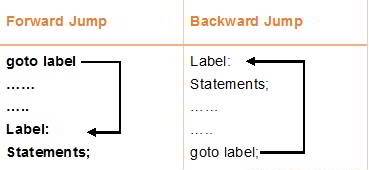- C-language provides goto statement to transfer control unconditionally to other part of the program.
- Although use of goto statement is not advisable but sometime it is desirable to use go to statement.
- It has the following form:

- goto statement requires a label to determine where to transfer the control.
- A label must end with colon (:)
- We can use any valid name as a label similar to variable name.
- When compiler encounters goto statement with a label name then, it transfers the control to the location where label has been defined in the program.
- When we use goto statement either some statement are execute repeatedly or skipped.
- When goto statement is placed after the label, control jumps backward direction and some statement are repeated. Such type of go to jump is called backward jump.
- When goto statement is placed before the label in the program, control transfers to the label and some statements are skipped. Such type of jump is called forward jump.
- In highly structure programming language such as c, it is not advisable to use go to statement.
- We should avoid using go to statement as far as possible because it affects performance of the program.
- the following program demonstrates the use of goto statement.
/* C program to calculate sum using goto statement.
#include "stdio.h"
#include "conio.h"
void main()
{
float x,y,sum;
clrscr();
input:
printf("\n Enter X and Y : ");
scanf("%f %f", &x, &y) ;
if( x <=0 || y <= 0)
goto input ;
sum = x + y ;
printf("\n Answer is %.2f", sum);
getch();
}

